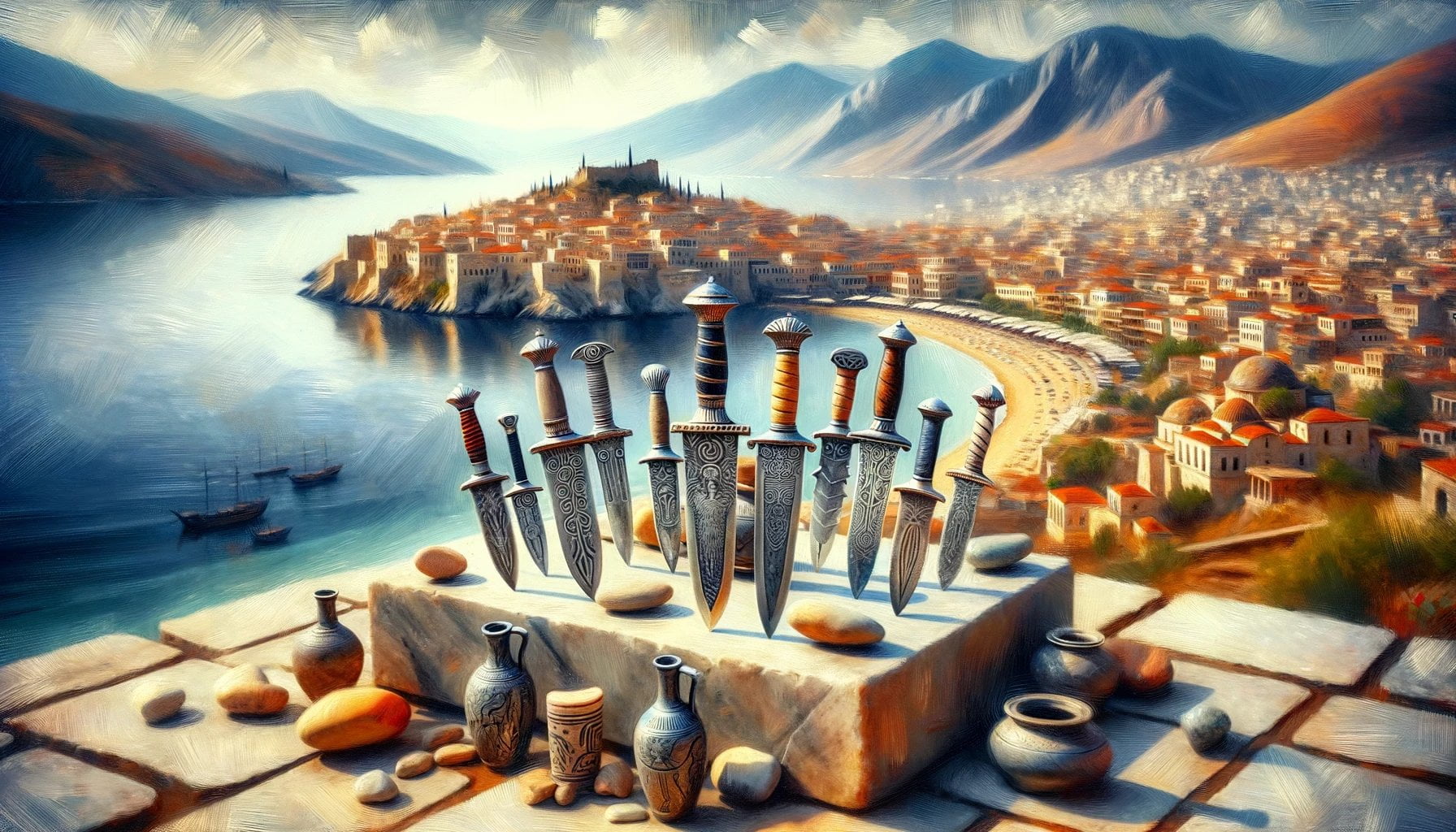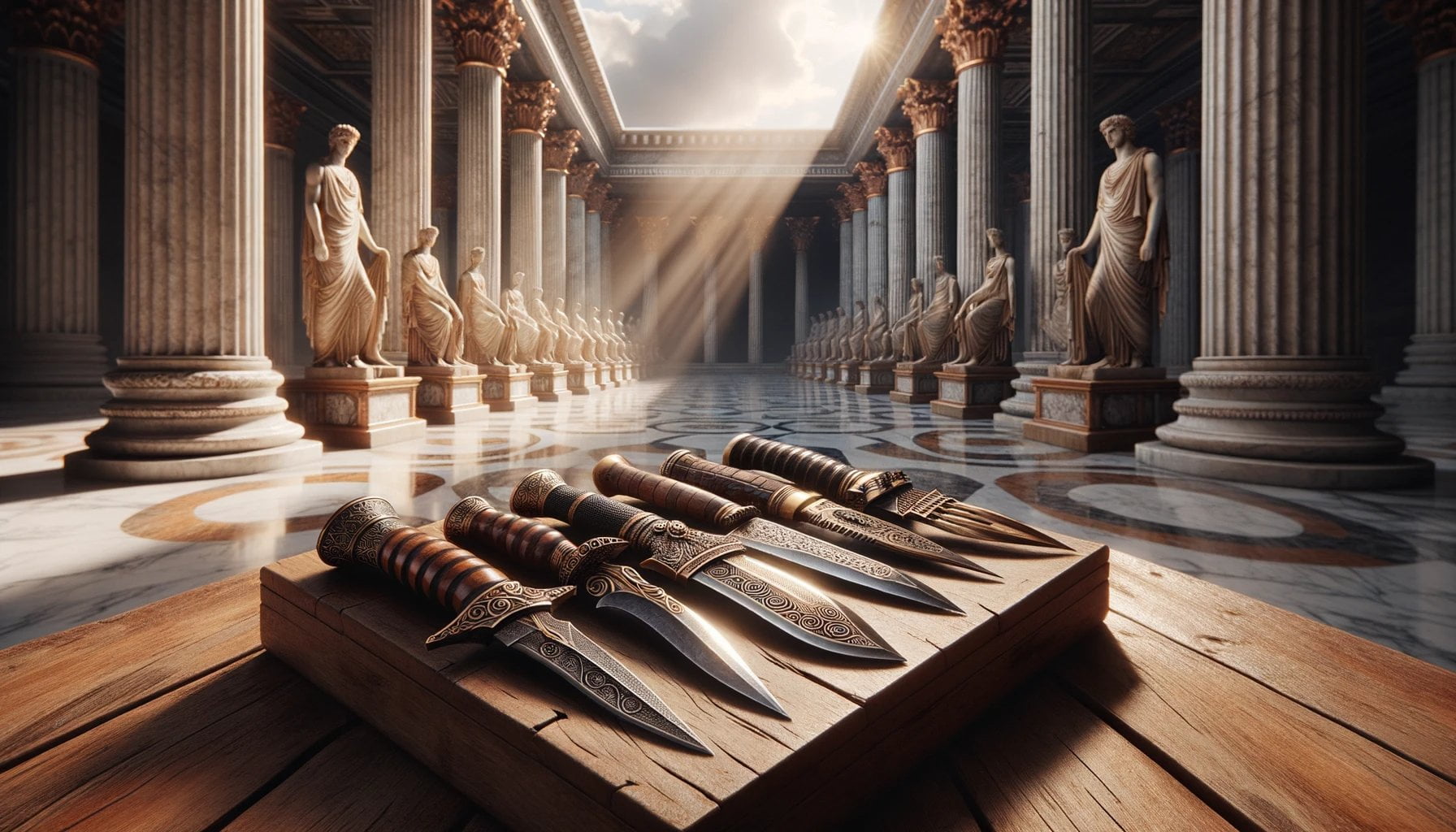Discover the captivating world of ancient Greek weaponry as we embark on a journey to explore the historical significance of their exquisite daggers. As an experienced archaeologist and historian specializing in this field, I have dedicated years to meticulously researching and excavating ancient sites throughout Greece. With a deep understanding of the craftsmanship, designs, and utilization of these weapons in warfare, I offer unique insights into their cultural and historical importance within ancient Greek society. Join me as we delve into the remarkable tales hidden within the ancient Greek daggers, uncovering their historical value and significance in a truly captivating way.
Key Takeaways:
- The acinaces, a type of dagger or short sword, was used by various cultures including the Greeks in the first millennium BCE.
- Prehistoric daggers were actually used for slaughtering animals, contrary to previously believed ceremonial use.
- Copper daggers first appeared in the early Bronze Age, around the 3rd millennium BC.
- The Ancient Greeks used various types of daggers such as the xiphos, kopis, and makhaira.
- The kopis, a one-handed weapon with a forward-curving blade, was believed to have originated from Etruscan culture.
- Daggers played a significant role in ancient Greek warfare as close combat weapons.
Ancient Greek Daggers: Exploring their Historical Significance

As an experienced archaeologist and historian specializing in ancient Greek weaponry, I have dedicated my career to unraveling the mysteries behind ancient artifacts. Today, I invite you to embark on a journey into the captivating world of ancient Greek daggers. Together, we will unveil the historical significance of these weapons and gain a deeper understanding of their craftsmanship, design, and utilization in warfare.
Unleashing the Stories behind Ancient Greek Daggers
Let us begin our exploration by delving into the fascinating history of ancient Greek daggers. Dating back to the first millennium BCE, the acinaces, a type of dagger or xiphos, appeared in the eastern Mediterranean Basin. This versatile weapon was wielded not only by the Greeks but also by other cultures such as the Medes, Scythians, Persians, Caspians, and more[^1^]. The acinaces, with its distinctive curved blade, played an integral role in the combat strategies of these ancient civilizations.
Moving further back in time, we stumble upon a revelation that reshapes our understanding of prehistoric daggers. Once believed to be non-functional ceremonial objects, it has now been discovered that these daggers were actually used for slaughtering and butchering animals during the early fourth millennium BCE[^2^]. This revelation highlights the practicality of ancient Greek daggers and their vital role in everyday life.
Masterpieces of Ancient Craftsmanship
Crafted with precision and artistic finesse, ancient Greek daggers were testaments to the unparalleled skill of ancient craftsmen. Copper daggers, the earliest known daggers, emerged during the early Bronze Age, approximately in the 3rd millennium BC. These remarkable artifacts showcase the early mastery of metalworking techniques among ancient Greek societies[^3^].
Among the various types of daggers used by the Greeks, three stand out prominently: the xiphos, the kopis, and the makhaira[^4^][^5^]. The xiphos, a straight-bladed weapon, was a staple in the arsenal of Greek soldiers. On the other hand, the kopis, with its forward-curving blade, held immense power, capable of delivering devastating blows. Scholars speculate about its potential Etruscan origin[^6^]. Lastly, the makhaira, characterized by its curved shape and single-edged blade, possessed a lethal elegance, making it a fearsome close-combat weapon[^5^].
Daggers: Silent Guardians of Ancient Greek Warfare
Now that we have acquainted ourselves with the exquisite artistry behind ancient Greek daggers, let us explore their role in the tumultuous realm of warfare. These weapons played a pivotal part in ancient Greek military strategies and were often wielded by soldiers engaging in close-quarter combat[^7^]. As the clash of armies resounded through the battlefield, daggers became the trusty companions of warriors, enabling swift and deadly strikes against their enemies.
In Conclusion
In conclusion, ancient Greek daggers serve not only as artifacts of historical significance but also as vessels that transport us back in time. Wielding these masterpieces of ancient craftsmanship, soldiers forged their path through the battlegrounds, leaving behind tales of valor and conquest. By unraveling the stories woven within these weapons, we gain a profound insight into the culture and society of ancient Greece.
So, as we reflect upon the historical significance of ancient Greek daggers, let us acknowledge the craftsmanship, design, and utility that made these weapons the epitome of ancient Greek warfare. Through their careful study, we pave the way for a deeper appreciation of these extraordinary relics, ensuring that their legacy endures for generations to come.
In ancient Greece, powerful and influential women held the title of queens. Learn more about these fascinating ancient Greek queens by clicking on the link: ancient greek queens.
The ancient Greek prophetesses were revered for their mystical abilities and prophetic visions. Delve into the world of ancient Greek prophetesses by following this link: ancient greek prophetess.
Discover the harsh and intriguing punishments that were administered in ancient Greece by clicking on this link: ancient greek punishment.
Uncover the various modes of transportation utilized in ancient Greece by exploring this link: greek transportation ancient.
The Types and Variations of Ancient Greek Daggers
In ancient Greece, daggers were more than just tools or weapons. They held significant cultural and historical value, serving various purposes in combat, ceremonies, and everyday tasks. Let’s explore the different types and variations of these ancient Greek daggers, shedding light on their craftsmanship and the roles they played in society.
1. The Xiphos: Versatile and Deadly
One of the most widely represented daggers in ancient Greece was the xiphos. This single-edged blade served as a primary weapon for Greek warriors. Its design allowed for quick and effective strikes in close-quarters combat. With a straight and double-edged blade, the xiphos was known for its practicality and versatility on the battlefield.
2. The Kopis: A Sword-Dagger Hybrid
In the realm of mounted warfare, the kopis sword-dagger hybrid reigned supreme. With its forward-curving blade and a single cutting edge, the kopis was specifically designed for slashing and hacking. Mounted soldiers found it particularly effective for delivering heavy blows from horseback, making it a formidable weapon during ancient Greek battles.
3. The Spartan Dagger: A Symbol of Fearless Warriors
The Spartan dagger, often associated with the renowned Spartan warriors, showcased both elegance and lethality. Featuring a double-edged and leaf-shaped blade, this dagger was crafted with precision and used by Spartans as a secondary weapon. It embodied the warrior ethos of the Spartans, symbolizing their fearlessness and martial prowess.
4. Unique Types Fell by the Wayside
While the xiphos, kopis, and Spartan dagger were noteworthy examples of ancient Greek daggers, there were other variations that have faded into history. The anelace, baselard, and even daggers from Java, Indonesia, like the kris and kujang, all possessed their own distinctive designs and functions.
Key Takeaways:
– Ancient Greek daggers, such as the xiphos and kopis, were essential tools in both combat and daily life.
– The xiphos, with its straight and double-edged blade, provided versatility on the battlefield.
– Kopis swords, featuring forward-curving blades, excelled in mounted warfare.
– The Spartan dagger served as a symbol of the renowned Spartan warriors’ martial prowess.
– Other types of daggers, like the anelace, baselard, and those from Java, Indonesia, also played a role in ancient Greek society.
Sources:
– What Were Daggers Used for in Ancient Greece? by Leslie Robbins
– 12 Different Types of Daggers by TypesOfList
The Role of Ancient Greek Daggers in Ancient Greek Society
Greek daggers played a significant role in the daily lives and cultural practices of ancient Greeks. These versatile weapons served various purposes, ranging from combat to religious ceremonies and everyday tasks. Let’s explore the fascinating role that ancient Greek daggers played in ancient Greek society.
Combat and Warfare:
– Ancient Greek daggers were essential weapons in close-quarter combat, providing soldiers with a deadly advantage.
– Soldiers relied on the agility and precision of daggers to fight in battles, where they showcased their martial prowess and fearlessness.
– The xiphos, kopis, and makhaira were prominent types of daggers used by Greek warriors, each having its own distinctive design and function.
– The xiphos, a versatile, single-edged dagger, was a favored weapon of Greek warriors due to its effectiveness and maneuverability on the battlefield.
– The kopis, a sword-dagger hybrid with a forward-curving blade, was predominantly used for slashing and hacking in mounted warfare.
– Spartans, known for their military might, wielded the Spartan dagger as a secondary weapon, symbolizing their martial prowess and fearlessness.
Ceremonial Significance:
– Ancient Greek society placed great importance on ceremonies and rituals, and daggers played a significant role in these practices.
– Daggers were used by priests and individuals performing religious rites, symbolizing their connection to the gods and their role as intermediaries between the divine and mortal realms.
– These ceremonial daggers were often intricately designed and adorned, reflecting the artistic skill and craftsmanship of ancient Greek artisans.
– The use of daggers in religious ceremonies underscored their symbolic value and their role in expressing devotion and reverence within Greek society.
Everyday Tasks and Symbolism:
– Ancient Greek daggers were not only tools of combat but also versatile instruments for everyday tasks.
– These daggers were indispensable for civilians, serving as hunting and butchering tools, as well as for various daily chores.
– Greek daggers were crafted with short blades, sharply tapered points, and usually two cutting edges, making them suitable for a range of practical applications.
– The craftsmanship and design of these daggers reflected the cultural values and aesthetic sensibilities of ancient Greek society.
– They were made from a variety of materials such as flint, bone, ivory, and copper, showcasing the innovation and resourcefulness of ancient Greek artisans.
Unveiling the Historical Significance:
– The study of ancient Greek daggers offers profound insights into the culture, society, and warfare practices of ancient Greece.
– These weapons provide historians and archaeologists with valuable evidence to reconstruct ancient military tactics, combative traditions, and religious practices.
– Excavations of archaeological sites have uncovered ancient Greek daggers intricately depicted in scenes of hunts, further shedding light on the roles of daggers in both practical and symbolic contexts.
– Analyzing the craftsmanship, materials, and design of these daggers enhances our understanding of ancient Greek society’s technological advancements and artistic achievements.
Key Takeaways:
– Ancient Greek daggers played a significant role in combat, religious ceremonies, and everyday tasks.
– They were versatile tools that warriors and civilians relied upon for their daily needs.
– Daggers held symbolic value within Greek society, serving as connections to the divine during religious practices.
– The craftsmanship and materials of Greek daggers showcased the artistic skill and technological advancements of ancient Greek artisans.
– Studying these daggers provides valuable insights into the culture, society, and warfare practices of ancient Greece.
The Symbolism and Cultural Significance of Ancient Greek Daggers
Daggers in ancient Greece held deep symbolic meaning and cultural significance. These weapons represented power, courage, and the ability to defend oneself in times of conflict. Throughout Greek history, daggers were not only practical tools but also objects of art and symbols of authority and valor.
The depictions of daggers in ancient Greek artworks, including pottery and sculptures, showcase their significance as symbols of power. They were often associated with individuals who held positions of authority and were admired for their bravery. These artistic representations highlight the cultural values placed on the possession and utilization of daggers.
In Greek mythology, famous daggers have significant cultural and symbolic meanings. They are seen as representations of power and are associated with epic stories and legends. Mythological heroes often wielded daggers, further emphasizing their connection to strength and heroism.
Daggers were not only important in Greek society but also in neighboring civilizations. For example, in ancient Egypt, daggers were made of copper or bronze, and royalty often had gold weapons. Adorned as ceremonial objects with golden hilts and intricate designs, these daggers signified the status and power of their owners.
It’s important to note that daggers were not only associated with positive symbolism. Due to their historic use, they also had associations with assassination and murders. This darker aspect of their symbolism adds layers of intrigue and complexity to the cultural significance of ancient Greek daggers.
In modern times, daggers have become iconic symbols in the fantasy genre, representing mankind’s struggle against evil forces. This further solidifies their powerful symbolism, as they continue to captivate and inspire people today.
Key Takeaways:
– Ancient Greek daggers held both practical and symbolic importance.
– They represented power, courage, and the ability to defend oneself.
– Daggers were often depicted in art as symbols of authority and valor.
– Mythological heroes often wielded daggers, emphasizing their connection to strength and heroism.
– Daggers in ancient Greece had associations with both positive symbolism and darker aspects such as assassination.
– Today, daggers continue to captivate and inspire, becoming iconic symbols in the fantasy genre.
References:
– “Dagger” – Wikipedia. Retrieved from en.wikipedia.org

FAQ
Q1: What were ancient Greek daggers used for?
A1: Ancient Greek daggers served multiple purposes such as combat, ceremonial use, and everyday tasks. They were versatile tools for both warriors and civilians.
Q2: Did daggers hold any symbolic value in ancient Greek society?
A2: Yes, daggers held symbolic significance in ancient Greece, representing power, courage, and the ability to defend oneself. They were often depicted in art as symbols of authority and valor.
Q3: What materials were ancient Greek daggers made of?
A3: Ancient Greek daggers were made of various materials including flint, ivory, bone, copper, and even gold for royalty.
Q4: Were daggers common in ancient Greek warfare?
A4: Yes, daggers played a significant role as close combat weapons in ancient Greek warfare. Soldiers would wield daggers during combat.
Q5: What types of daggers were used in ancient Greece?
A5: The Ancient Greeks used different types of daggers, including the xiphos, kopis, and makhaira. The kopis, with its forward-curving blade, was particularly suited for mounted warfare.
- Crypto Quotes’ Red Flags: Avoid Costly Mistakes - June 30, 2025
- Unlock Inspirational Crypto Quotes: Future Predictions - June 30, 2025
- Famous Bitcoin Quotes: A Deep Dive into Crypto’s History - June 30, 2025
















